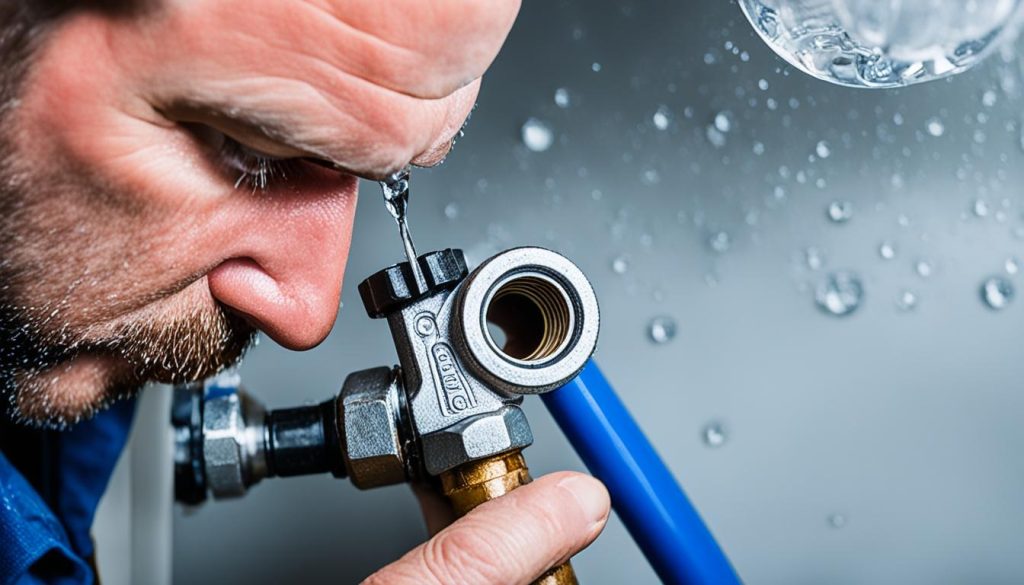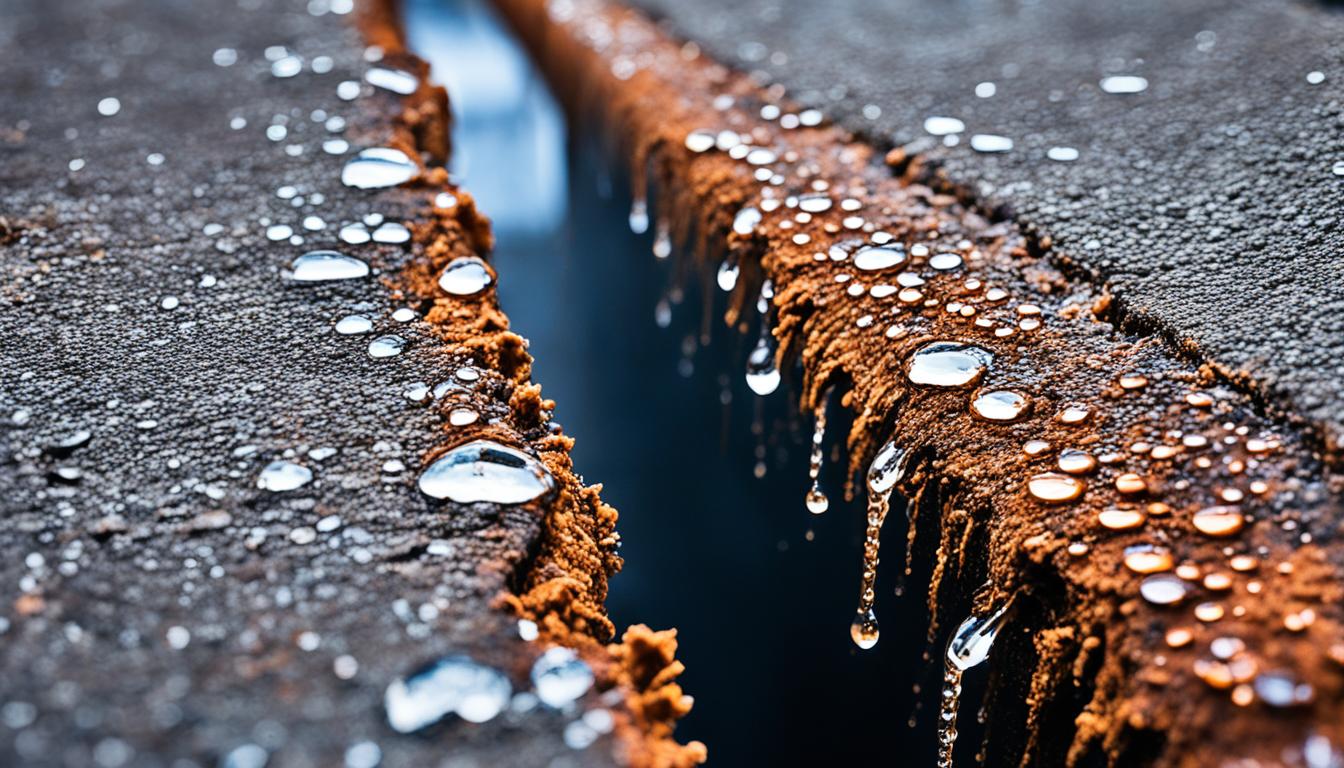Did you know that even a small pipe leak can waste up to 10,000 gallons of water per year? That’s enough water to fill a swimming pool!
Dealing with a leaking pipe can be a stressful and costly situation. Whether you’re facing a small drip or a larger leak, it’s important to take immediate action to prevent further damage and save water. Thankfully, there are several effective methods to stop a pipe from leaking, both temporarily and permanently.
Key Takeaways:
- Temporary fixes for small leaks include using epoxy putty or rubber sleeves with clamps.
- For larger leaks, consider solutions such as slip couplings or repair casts.
- Tightening loose connections can also help stop leaks.
- Repairing leaky pipe threads and replacing damaged washers are other effective methods.
- For PEX piping, fittings and clamps are the go-to solutions for repair.
Temporary Fixes for Small Leaks
If you’re dealing with a small leak in a pipe, there are a few temporary fixes you can try before seeking a permanent solution. These quick DIY pipe leak fixes can help you stop the leak and prevent further damage.
Epoxy Putty
One effective temporary fix for small leaks is to use epoxy putty. Epoxy putty is a versatile repair material that can be molded onto the pipe to cover the leak. Here’s how you can use epoxy putty to fix a small pipe leak:
- Turn off the water supply to the affected pipe.
- Drain the pipe to remove any remaining water.
- Prepare the epoxy putty according to the manufacturer’s instructions.
- Apply the epoxy putty to the leak, making sure to cover it completely.
- Allow the epoxy putty to harden for 5-10 minutes.
- Turn the water supply back on and check for any remaining leaks.
Epoxy putty provides a temporary fix that can hold up against small leaks. However, keep in mind that it is not a permanent solution. It’s important to monitor the repaired area and seek further repairs or replacements if necessary.
Rubber Sleeve and Clamp
Another quick pipe leak solution is to use a rubber sleeve and clamp. This method is especially useful for fixing small leaks in pipes with larger diameters. Here’s how you can temporarily fix a small pipe leak using a rubber sleeve and clamp:
- Turn off the water supply to the affected pipe.
- Drain the pipe to remove any remaining water.
- Wrap a rubber sleeve tightly around the leak.
- Secure the rubber sleeve in place with a clamp.
- Tighten the clamp securely to create a watertight seal.
- Turn the water supply back on and check for any remaining leaks.
The rubber sleeve and clamp provide a temporary fix that can buy you some time before pursuing a permanent solution. Always keep an eye on the repaired area and take further actions if needed.
Remember, these temporary fixes should only be used as a stopgap measure. It’s crucial to address the underlying issue and seek a permanent solution to ensure the long-term integrity of your plumbing system.
Next, let’s explore the permanent fixes for larger leaks in Section 3.
Permanent Fixes for Larger Leaks
When it comes to larger leaks in pipes, temporary solutions may not be sufficient. To ensure a long-lasting and effective fix, permanent solutions are necessary. Here are two options that can help you prevent pipe leakage and provide lasting pipe repair:
1. Slip Coupling Method
The slip coupling method involves cutting out the damaged section of the pipe and replacing it with a slip coupling. This method is ideal for straight pipes and provides a secure connection between the two sections of pipe, preventing any further leakage.
| Steps | Materials Needed |
|---|---|
|
|
2. Repair Cast with Fiberglass Tape
The repair cast method involves using an epoxy-like putty and fiberglass tape to seal the leak. This method is particularly effective for larger leaks and offers a strong and durable repair solution.
| Steps | Materials Needed |
|---|---|
|
|
By implementing these permanent pipe repair methods, you can effectively prevent pipe leakage and ensure the longevity of your plumbing system.

Tightening Loose Connections
In some cases, leaks can occur where pipes connect to one another due to loose coupling nuts. To stop pipe leaks efficiently, it is important to address these loose connections. Here’s a quick and easy plumbing repair method for coupling nut repair:
Tightening the Connection
To tighten loose coupling nuts, you will need a wrench. Follow these steps:
- Secure one wrench onto the pipe.
- Secure another wrench around the coupling nut.
- Turn the wrench clockwise to tighten the connection.
By tightening these loose connections, you can effectively prevent leaks and ensure efficient plumbing repair. Let’s take a look at an example of how to perform coupling nut repair:
| Tools Needed | Materials Needed |
|---|---|
|
|
With the right tools and techniques, you can efficiently stop pipe leaks and ensure your plumbing system is in good working condition. Now that you know how to tighten loose connections, you can confidently tackle plumbing repairs in your home.
Repairing Leaky Pipe Threads
If the leak is coming from the pipe threads, using plumbers tape can create a reliable seal. Follow these steps:
- First, turn off the water supply and drain the pipe to prevent any water from leaking.
- Next, unscrew the nuts holding the pipes together to expose the threading.
- Starting 2 threads back from the end of the pipe, apply plumbers tape in the same direction as the thread spiral.
- Pull the tape tightly and firmly press it against the threads as you wrap it 2-4 times.
- Cut the tape and press down the loose end to secure it.
- Reattach the pipe by screwing the nuts back on tightly.
- Finally, turn on the water supply and test for any leaks. If needed, reapply the tape for a tighter seal.
Benefits of Using Pipe Thread Sealant
Using pipe thread sealant, such as plumbers tape, offers several advantages:
- Creates a watertight seal: Plumbers tape effectively seals the pipe threads, preventing any water or gas leakage.
- Easy to apply: Applying plumbers tape is a simple and quick DIY plumbing fix that requires no specialized tools.
- Durable and long-lasting: Properly applied plumbers tape can provide a reliable seal for an extended period.
- Cost-effective solution: Pipe thread sealant is an affordable option compared to more complex repairs or replacements.

| Pros | Cons |
|---|---|
| Effective in sealing pipe threads | May need periodic reapplication |
| Easy to apply | Not suitable for all types of pipe connections |
| Provides a cost-effective solution | Requires proper wrapping technique for optimal results |
| Durable and long-lasting | May not be suitable for high-pressure pipes |
Replacing Damaged Washers in Pipe Connections
If you’re experiencing a leak in your plumbing joint, it may be due to damaged washers. Fortunately, replacing these washers is a straightforward process that can help you stop the leak and restore the integrity of your pipe connections.
To begin, follow these steps:
- Turn off the water supply to prevent further leakage.
- Unscrew the leaky connection using an appropriate wrench or pliers.
- Within the fitting, locate the circular rubber washer that may be causing the problem.
- Inspect the washer for any cracks, tears, or general damage. If it’s visibly damaged, it’s time for a replacement.
- Remove the damaged washer carefully.
- Obtain a new rubber washer that matches the size and shape of the original one.
- Insert the new washer into the fitting, ensuring it sits securely and covers the joint properly.
- Tighten the connection by screwing it back together, ensuring a snug fit without over-tightening.
Once the new rubber washer is in place and the connection is secure, you can turn the water supply back on and check for any signs of leaking. If the replacement was successful, the leak should now be resolved, and your pipe connections should function properly.
Rubber Washer Sizes for Common Pipe Connections
| Pipe Diameter | Washer Size |
|---|---|
| 1/2 inch | 1/2 inch rubber washer |
| 3/4 inch | 3/4 inch rubber washer |
| 1 inch | 1 inch rubber washer |
| 1 1/4 inches | 1 1/4 inch rubber washer |
| 1 1/2 inches | 1 1/2 inch rubber washer |
It’s important to note that the table above provides general guidance, but it’s always best to check the specific requirements of your plumbing system and fittings to ensure you select the correct washer size.
Replacing damaged washers in pipe connections is an effective way to repair a leaking joint. By following the steps outlined above and using the appropriate washer size, you can easily resolve the issue and prevent further water damage to your plumbing system.
Repairing PEX Piping with Fittings and Clamps
If you have a PEX pipe that is leaking, don’t worry! You can easily repair it using PEX fittings and pipe clamps. Follow these steps to fix the issue:
- First, turn off the water supply to prevent any further leakage.
- Locate the damaged section of the PEX pipe.
- Using pipe cutters, carefully cut out the damaged section of the pipe.
- Now, take a cylindrical PEX fitting and slide it into one cut end of the pipe.
- Connect the other end of the fitting to the second pipe.
- Next, secure pipe clamps onto each side of the fitting.
- Tighten the clamps securely to create a tight seal.
- Once everything is properly secured, turn on the water supply and check for any remaining leaks.
- If you notice any leaks, tighten the clamps further until the pipe is completely sealed.
By following these simple steps, you can easily repair a leaking PEX pipe using fittings and clamps. Now you can enjoy a leak-free plumbing system.
| Materials Needed | Tools Required |
|---|---|
| PEX fittings | Pipe cutters |
| Pipe clamps | Wrench |
Cleaning Up After Fixing a Leaky Pipe
After successfully fixing a pipe leak, it’s crucial to take the necessary steps to clean up any water and prevent further damage. Begin by removing any items from the affected area, especially cabinets or other spaces where water may have accumulated. Use towels to soak up any excess water and ensure the area is dry.
Next, it’s essential to wipe down the entire area with a disinfectant or a bleach solution to prevent the growth of mold and mildew. Pay close attention to any surfaces that came into contact with the leaked water. This step will not only ensure cleanliness but also safeguard the affected area from potential health hazards.
To effectively dry out the area and prevent any lingering moisture, use a dehumidifier and a fan. These devices will help extract excess moisture, reducing the risk of further damage or mold growth. It’s also advisable to inspect any cabinets or storage spaces in the vicinity for any signs of damage. If necessary, consider replacing damaged cabinets to maintain the integrity of your space.
Source Links
- https://www.wikihow.com/Fix-Leaking-Pipes
- https://www.homedepot.com/c/ah/how-to-fix-a-leaky-pipe/9ba683603be9fa5395fab90a6c87071
- https://www.homeserve.com/en-us/blog/how-to/fix-leaking-pipe/
